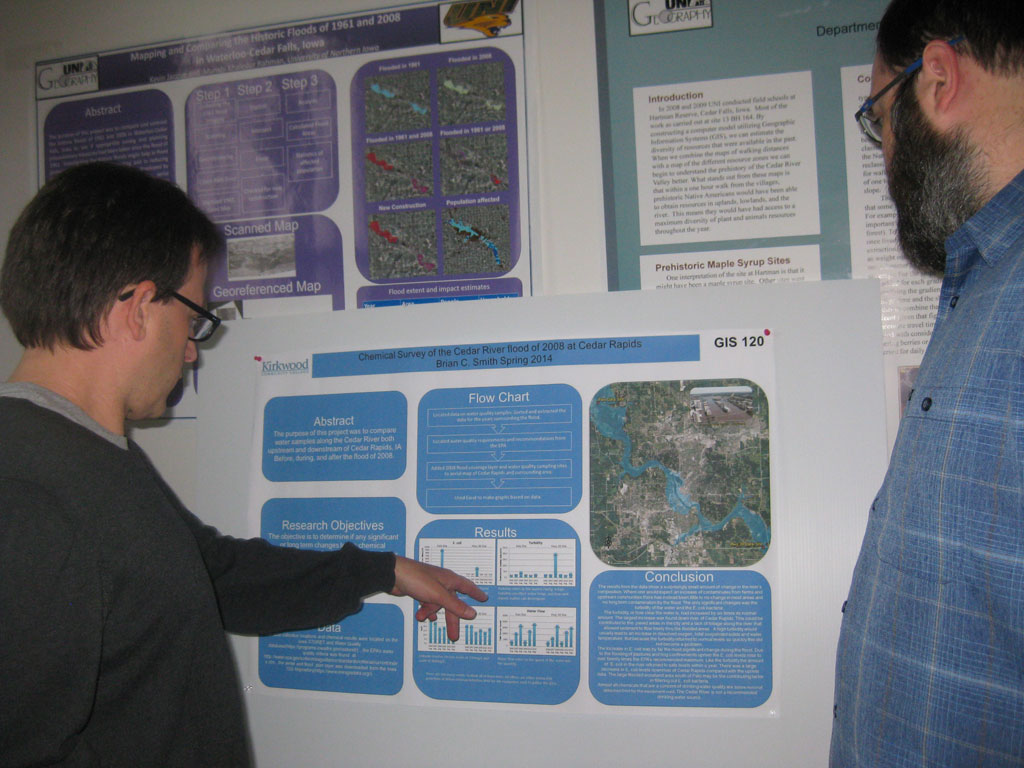Participants in the program look over a student project
Kirkwood GIS students find increased job openings, extended opportunities via “bridge” partnership with UNI
Students in Gail Brown’s computer labs are quite familiar with a bird’s-eye view of our planet. On a Tuesday morning in early spring, more than a dozen students are poring over various satellite and graphic maps of roads, streets and plots of Iowa farmland. As they click on various images, color-coded layers appear and disappear. The colors may represent everything from registered voters and age ranges in residential areas, to woodlands, crop rotations and soil types in the country.
The students are enrolled in the Geographic Information Systems program at Kirkwood Community College. The technical skills and application knowledge obtained through Kirkwood’s two-year GIS program have already opened employment opportunities for hundreds of graduates over the past decade.
Those opportunities have broadened when students pursue four-year and even graduate degrees through programs such as the one at the University of Northern Iowa. A new cooperative “bridge program” venture between the two colleges has allowed Kirkwood students to visit the UNI campus, interacting with faculty and students while exploring cutting-edge work in GIS professions. UNI professors also visit with the students at Kirkwood, giving early guidance on individual projects before they journey to Cedar Falls to present their findings.
Brown says the cooperative work between the two schools is “unique to Iowa” and possibly the Midwest.
“We appreciate the time that UNI faculty spend with our students at Kirkwood, and the visits we get to make at Northern Iowa, too. Their interactions with our students help grow their knowledge of the field and careers,” Brown said.
Dr. Patrick Pease is associate professor and head of UNI’s Department of Geography. He applauds the work of Brown and Kirkwood in teaching GIS skills and tools, and sees a “strong relationship” between the two colleges.
“We currently have seven undergraduates and one graduate student at UNI, who came to us from the Kirkwood bridge program,” Pease observed. “Another 8 to 10 students have already graduated from UNI, who came to us as transfer students from Kirkwood. The more structured bridge program has only strengthened that relationship.”
As he considers careers in the field, Pease believes the opportunities are quickly growing across many areas of the economy.
“Careers in GIS are very diverse because we’ve reached a point where almost everyone is using some sort of geospatial data. We have numerous interns and alumni in county and city offices. They work on things like utilities mapping, urban planning and economic development. At the state level there are jobs at the DOT and DNR, while federal jobs include various agencies from NOAA and FEMA to the CIA,” Pease said.
UNI graduates can now be found at Midwest employers as diverse as Garmin International in Kansas City, the City of Dubuque, Alliant Energy, John Deere and the U.S. Army Corps of Engineers.
One student who has graduated from both Kirkwood and UNI’s GIS programs is Hannah Whitehouse. The Cedar Rapids native transferred from Kirkwood to Northern Iowa in 2011, and two years later put her new UNI degree to work in the Linn County Auditor’s office. There she helps maintain the county’s extensive real estate data.
“My work involves updating ownership information when a property is sold and maintaining the county’s GIS parcel data, based on sales and surveys. I also regularly create maps for owners who are curious about their property boundaries,” she said.
Whitehouse also observed that she truly “grew up with the technology” that she now uses in her daily work for Linn County.
“My dad works for Rockwell Collins and has been involved in GPS since its earliest days. GPS and GIS and integrally related and I heard a lot about it from him, before I learned that Kirkwood offered a program in GIS,” Whitehouse added.
As the depth and accessibility of GIS data continues to grow and evolve, future data-driven jobs that interpret and add value to this data should also expand. Gail Brown sees many benefits and possibilities with the Kirkwood/UNI bridge program.
“Our hope at both schools is that this ongoing, face-to-face interaction will not only motivate students in their studies, but also make the transition from Kirkwood to their four-year studies less stressful and more successful. The UNI professors and students have gone out of their way to make it beneficial and useful. Plus, we are simply having a great time learning together!”
More information on the Kirkwood Geographic Information Systems program and the bridge project with UNI are available from Gail Brown in Kirkwood’s Nielsen Hall: Gail.brown@kirkwood.edu.

